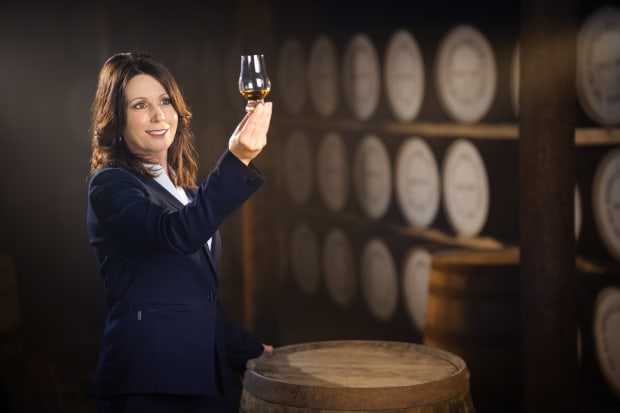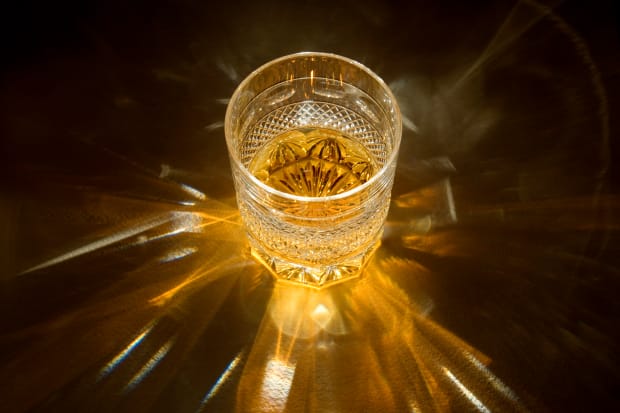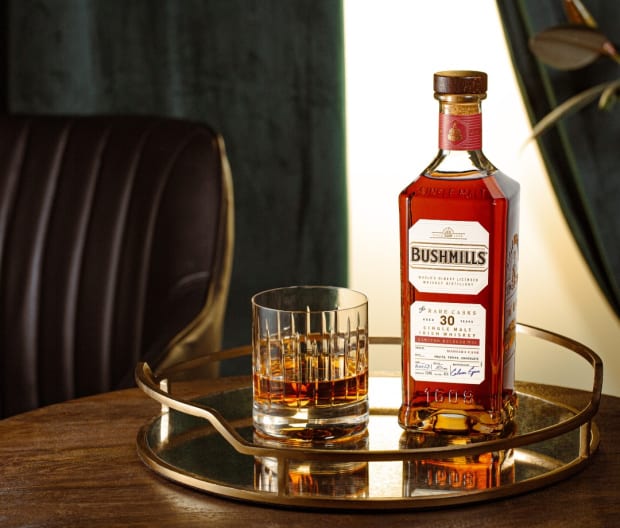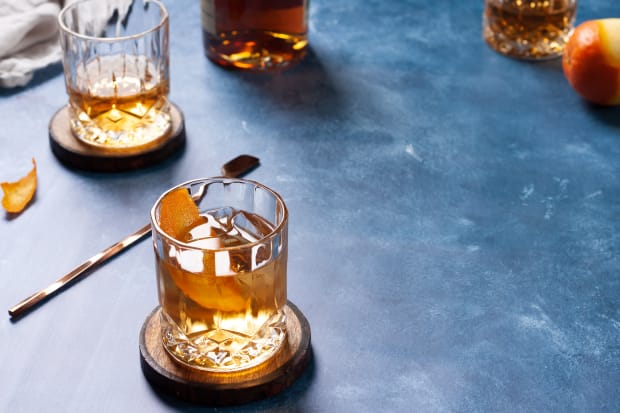Master blender Alex Thomas is on a mission to prove Bushmills is still an Irish whiskey innovator, even after 400 years.
They say you can’t teach an old dog new tricks. But the proverb certainly doesn't apply to distilling whiskey? Bushmills, technically the oldest licensed distillery in the world, is certainly making the case. Master distiller Alex Thomas is on a mission to prove the brand is still an Irish whiskey innovator, even after 400 years.
Pushing past a hidden library door that leads into Bushmills’ speakeasy-style boardroom, Thomas stands at the ready to walk our group through a tasting of the distillery’s latest releases, as well as some that haven’t yet hit shelves. Dram in hand, she speaks fervently about her single malts, as one might pridefully describe their overachieving children.
Together, we sip golden-hued distillates that've been aging for 30 years in bourbon and sherry casks—leagues above what many perceive an Irish whiskey to be capable of. Over her time at Bushmills, Thomas has become somewhat of a figurehead for the comeback of the category, also serving as inspiration to those who may not have considered a career in distilling to be plausible.

Courtesy Image
Luck of the Irish: How Alex Thomas Became a Master Blender
Prior to her time at Bushmills, Thomas was a timber merchant near her small hometown of Ballymoney, in Northern Ireland.
“One night, my husband came home and told me about a job opening at the distillery. If you ask anyone on the North Coast, they’ll tell you that working at Bushmills is a dream job, so I jumped at the chance. When I got the job, I joined an amazing team of people who were so passionate about what they did, I knew a career in whiskey was right for me,” she says.
Related: The 50 Best Whiskeys in the World
Twenty years and one distilling diploma later, Thomas became master blender for The Sexton, a single malt brand distilled at Bushmills, becoming one of the only women in the country to hold such a title.
“As the whiskey industry grows, women are undoubtedly becoming more involved and forging careers they may have never chosen in the past, and I’m delighted to say I’m no longer one of the only female master blenders in Ireland,” she says.
“Nothing is more empowering than doing what you love and having the freedom to share that experience and knowledge, so it’s an honor to be part of the group of women increasing awareness and representation.”

The Rise, Fall, and Resurgence of Irish Whiskey
While Scotland enjoys a glowing reputation for producing some of the world’s most covetable single malts, they actually originated in Ireland. That fact is little-known due to a decades-long slump in the Irish whiskey market, the same reason many are surprised to hear Irish whiskey dominated the wider category in the 19th century—accounting for over 50 percent of global sales of the spirit at the time.
“With the U.S. being the biggest market for Irish whiskey, the category was very much affected during Prohibition,” explains Thomas, “and what was once a country of hundreds of distilleries, became a country of a mere handful, with Bushmills being one of the very few left standing.”
Related: Single Pot Still Irish Whiskey Is Having a Comeback. Get Your Hands on These 10 Bottles
Along with the massive sales blow from the start of Prohibition laws in the States, Ireland’s newfound independence from Britain in 1922 led to the loss of key colonial export markets. Sensing an advantage, Scotland stepped in with shiny new column stills and the ability to export product to Canada (then a British colony).
By the 1980s the situation was looking bleak, with the number of operating distilleries dwindling down to just two: Bushmills and Midleton. It was a low point that made many wonder whether Irish whiskey would eventually disappear entirely.

Luckily, the broader whiskey category began to experience a worldwide resurgence, especially in the past two decades. As the profile of the “typical” whiskey drinker has evolved and diversified, so too have whiskey offerings. The explosion of craft distilleries both in the U.S. and internationally have yielded innovation, and multinational portfolios began to take bets on Ireland’s comeback.
Good thing they did, as more than six million cases of the spirit were sold in the U.S. last year, according to the Distilled Spirits Council of the United States. Now, over 40 distilleries dot the small country, producing single malts that straddle the line between historic precedence and modern creativity. One brand, Powers Irish Whiskey, recently unveiled a 100-percent Irish rye whiskey crafted at the Midleton Distillery with domestic rye—a first for the market.
“Consumers are finding their love for Irish whiskey again and exploring further into a category that Bushmills has been a leader in for centuries,” says Thomas. “With each exciting new launch to the market, we are helping to disprove and chip away at those misconceptions. This year is really going to be an exciting time for the brand and we can’t wait for everyone to experience it.”

A New Way to Whiskey
Flavors of rich caramel, dried figs and plums, and heady wood commingle in my dram, forming syrupy “feet” inside the walls of the glass, as Thomas divulges another way she wants to see single malt Irish whiskey evolve—the way it’s enjoyed.
“There's a certain stigma around whiskey: that it should only be drunk neat, but like so many other aspects of the category—this is changing,” she says.
While some whiskey enthusiasts might turn over in their grave at the thought of a 30-year-old single malt being shaken or stirred into a cocktail, Thomas asserts that “whiskey is made to be enjoyed,” and insists that the quality of the liquor will shine through no matter the way it's consumed.
This ideology is representative of a wider mental shift in modern cocktail culture, as more bar patrons step outside their comfort zone to try concoctions made with exotic ingredients, gastronomic methods, and high-quality spirits that are usually reserved for a neat pour. It’s this evolution that can hopefully help to pull certain prestigious spirits into the 21st century, from single malt whiskey to XO cognac. It's perhaps no coincidence The Sexton’s brand mantra reads, “You Have a Single Life. Drink A Single Malt.”
One also has to wonder whether it's because of Ireland’s long slump that emerging players in the category now feel they have a proverbial blank slate to work with, leading to a more playful take on finishing and, ultimately, a more interesting product. It helps that the Irish aren't constrained to maturing their product in oak.
Related: Here's the Difference Between Bourbon and Whiskey
"We have less restrictions and more freedom than Japanese or Scotch whisky,” says Thomas. “Because of this, Irish whiskey has a lot more to offer in terms of innovation with unique finishes and cask types in comparison to others”
Thomas tells us that, despite its centuries-old history, Bushmills has just begun to scratch the surface in terms of its abilities to innovate, hinting that they’re looking forward to launching new whiskeys over the next several years that'll exemplify the power of the distillery and its 400 years of whiskey-making know-how.
“An ultimate goal of mine is to see Irish become the leader in the single malt category again, and knock Scotch off the number-one spot. That's where the future of Irish whiskey lies for me—when someone hears the term single malt, they’ll think of Irish and when they think of the original Irish single malt, they'll think of Bushmills. Then I can retire happy.”
from Men's Journal https://ift.tt/2oBNGEl


0 comments